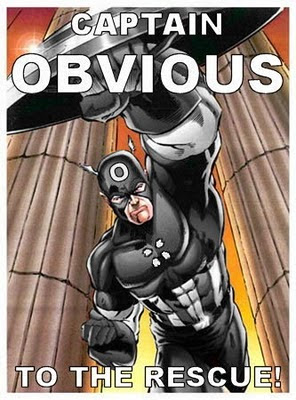Every client coming through the door is different and will have a different goal. I focus all of my training around the idea that the basic exercises work. Improve mobility and get stronger; that's the key to getting the body you want.
However, there are many paths that lead to the same goal. Do you train a powerlifter, basketball player and desk jockey the same way? Of course not. Beyond the sets and reps being different, your entire exercise selection will be different.
How different can your exercises be? Well, let's get technical. First off, you can classify exercises as a "push" or a "pull". After that you can decide on the plane of motion, mainly vertical or horizontal. The last aspect is uni-lateral or bi-lateral, that is one or two limbs.
 |
| Uh, yeah, this "exercise" doesn't count as anything. |
Now that we've broken down the movement patterns, how do you choose exercises? Simple, use the ones that don't suck. Deadlifts, squats, pushups, pull-ups, over head presses and rows. Pretty easy, right? Well, each population of clients are going to have different needs within these specific exercises.
Mike Boyle and Eric Cressey are masters at using different exercise variations and implements in order to safely train different populations of clients. Boyle made waves with his "Death to the Squat" series, where he says he will never back squat another one of his athletes. Cressey is really well known for his use of medicine balls and sled pushes for power production instead of using the Olympic lifts.
How many variations are there really? Well, how much time you got? Each barbell exercise has a few variations...think sumo deadlift, box squat, front squat, military press, push press, Zercher squat, etc. Now add in the different specialty bars you can get, and the options are nearly endless.
How does this all apply to different populations? Pretty simple. As Eric Cressey likes to say "there are no contraindicated exercises, only contraindicated athletes." What he means is that (almost) every exercise is a good exercise. The barbell back squat is a great exercise; but not for a baseball pitcher. The barbell deadlift is an amazing exercise; but not for a 6'9" basketball player. The bench press? Great exercise, but maybe not for the desk jockey suffering from kyphosis.
How can these specialty bars help us overcome these contraindications? There are certain bars out there that will allow you to perform the same exercise, with some modifications to the position of your body.
A Yoke Bar will let an athlete with a shoulder contraindication (mobility or repetitive stress) to back squat pain free.
The Swiss bar / Football Bar will let a client or athlete with shoulder / thoracic spine contraindications do some pressing movements with a safer range of motion due to better grip options.
A trap bar or hex bar will let just about anyone deadlift from the floor in a really short amount of time. The hex bar has handles that are a little higher, which will help people with limited hip mobility. The bar also allows the user to hold the weight at the mid-line of their body, instead of having the load anterior to the center of gravity. This allows people to pull a little more weight in a safer manner.
There are a bunch of different bars out there beyond these three: the bow bar for benching ROM, the giant cambered bar (GCB) which changes the center of gravity for the weights, making certain movements feel different. Fat bars which make every exercise a challenge for your grip. Even a barbell made with bamboo that you can attach resistance bands and kettlebells to!
Now, some people will say that if you can't do an exercise the "right" way, you shouldn't be doing it at all. I saw, who cares? If my athlete is a baseball player and not a power lifter, why do they have to be able to do a barbell back squat Ass To Grass when a safety bar box squat will work? If she is a lawyer and not competing in olympic lifting, who cares if she can perform a perfect clean or if we develop power with medicine ball throws? If my athletes and clients are getting strong, what does it matter? What you eat doesn't make me shit.
We have all these exercise variations and choices for a reason, not everything works for everybody. Would training be much simpler if everyone had the proper shoulder/thoracic spine function and could perform snatches safely? Yup, it'd be so easy a monkey could do it. I think the real trick is being able to take 5 different populations with different considerations and get them all equally strong using different methods and techniques.
Stick to the basics, try a different variation. Change takes change.
How does this all apply to different populations? Pretty simple. As Eric Cressey likes to say "there are no contraindicated exercises, only contraindicated athletes." What he means is that (almost) every exercise is a good exercise. The barbell back squat is a great exercise; but not for a baseball pitcher. The barbell deadlift is an amazing exercise; but not for a 6'9" basketball player. The bench press? Great exercise, but maybe not for the desk jockey suffering from kyphosis.
How can these specialty bars help us overcome these contraindications? There are certain bars out there that will allow you to perform the same exercise, with some modifications to the position of your body.
A Yoke Bar will let an athlete with a shoulder contraindication (mobility or repetitive stress) to back squat pain free.
The Swiss bar / Football Bar will let a client or athlete with shoulder / thoracic spine contraindications do some pressing movements with a safer range of motion due to better grip options.
A trap bar or hex bar will let just about anyone deadlift from the floor in a really short amount of time. The hex bar has handles that are a little higher, which will help people with limited hip mobility. The bar also allows the user to hold the weight at the mid-line of their body, instead of having the load anterior to the center of gravity. This allows people to pull a little more weight in a safer manner.
There are a bunch of different bars out there beyond these three: the bow bar for benching ROM, the giant cambered bar (GCB) which changes the center of gravity for the weights, making certain movements feel different. Fat bars which make every exercise a challenge for your grip. Even a barbell made with bamboo that you can attach resistance bands and kettlebells to!
Now, some people will say that if you can't do an exercise the "right" way, you shouldn't be doing it at all. I saw, who cares? If my athlete is a baseball player and not a power lifter, why do they have to be able to do a barbell back squat Ass To Grass when a safety bar box squat will work? If she is a lawyer and not competing in olympic lifting, who cares if she can perform a perfect clean or if we develop power with medicine ball throws? If my athletes and clients are getting strong, what does it matter? What you eat doesn't make me shit.
We have all these exercise variations and choices for a reason, not everything works for everybody. Would training be much simpler if everyone had the proper shoulder/thoracic spine function and could perform snatches safely? Yup, it'd be so easy a monkey could do it. I think the real trick is being able to take 5 different populations with different considerations and get them all equally strong using different methods and techniques.
Stick to the basics, try a different variation. Change takes change.










































